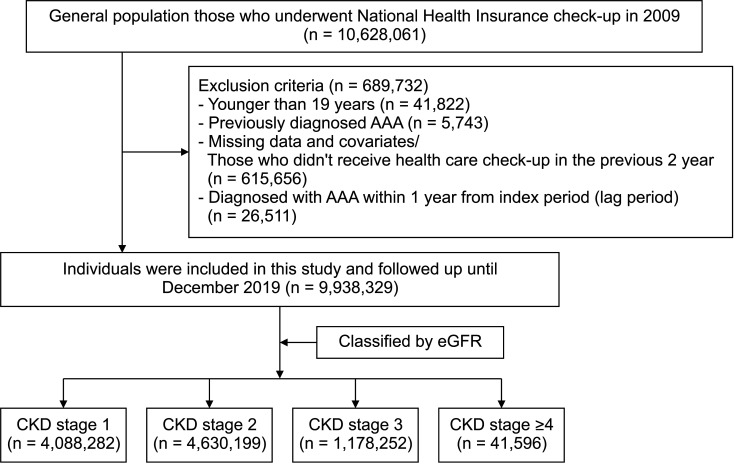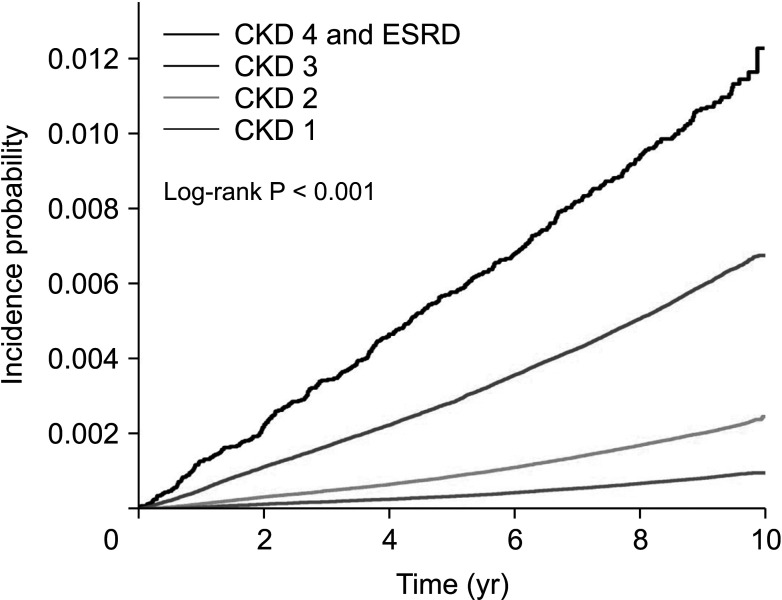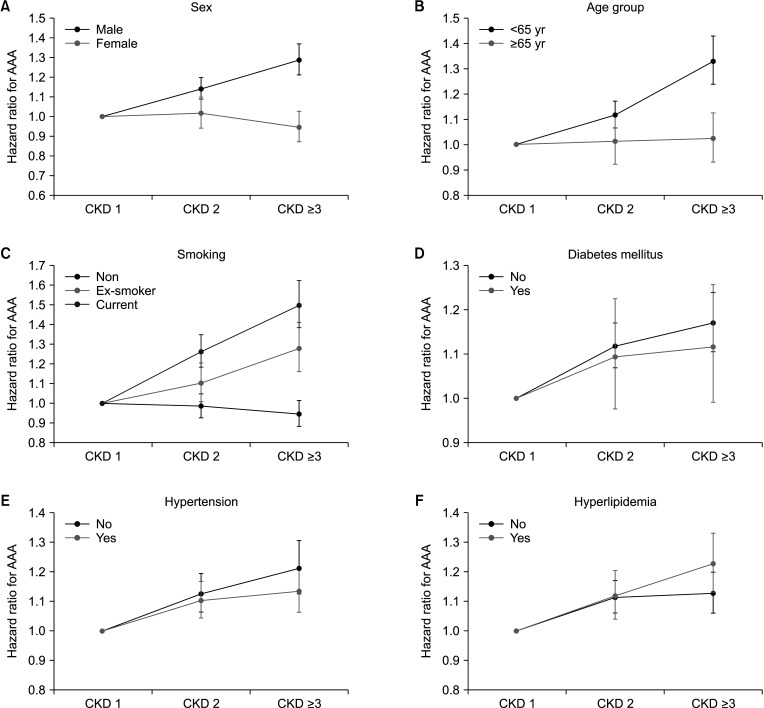Ann Surg Treat Res.
2022 Nov;103(5):297-305. 10.4174/astr.2022.103.5.297.
Chronic kidney disease as a risk factor for abdominal aortic aneurysm: a nationwide population-based study
- Affiliations
-
- 1Division of Vascular and Transplant Surgery, Department of Surgery, Bucheon St. Mary’s Hospital, College of Medicine, The Catholic University of Korea, Seoul, Korea
- 2Department of Biomedicine and Health Science, College of Medicine, The Catholic University of Korea, Seoul, Korea
- 3Department of Surgery, Kangdong Sacred Heart Hospital, Seoul, Korea
- 4Division of Vascular and Transplant Surgery, Department of Surgery, Eunpyeong St. Mary’s Hospital, College of Medicine, The Catholic University of Korea, Seoul, Korea
- 5Department of Statistics and Actuarial Science, Soongsil University, Seoul, Korea
- KMID: 2534855
- DOI: http://doi.org/10.4174/astr.2022.103.5.297
Abstract
- Purpose
Chronic kidney disease (CKD) is a well-known risk factor for cardiovascular outcomes; however, its association with abdominal aortic aneurysm (AAA) remains unknown. To investigate this association, a national wide population study has been undertaken.
Methods
This cohort study extracted data from the Korean National Health Insurance System database for individuals who had health checkups in 2009. The incidence of AAA was ascertained through the end of 2019. The study population was classified into 4 groups based on the CKD stage: stages 1, 2, 3, and ≥4. The primary endpoint was newly diagnosed AAA.
Results
During the mean follow-up of 9.3 years, a total of 20,760 patients (0.2%) were diagnosed with AAA. The incidence rates of AAA were 0.10, 0.23, 0.67, and 1.19 per 1,000 person-years in stages 1, 2, 3, and ≥4, respectively. In Cox proportional hazard model, advanced stage of CKD was associate with an increased risk of AAA development after adjusting full covariates (hazard ratio [95% confidence interval]: 1.12 [1.07–1.67], 1.16 [1.10–1.23], and 1.3 [1.15–1.46]; CKD stage 2 to ≥4, respectively; P < 0.001). There was a positive correlation between the degree of dipstick proteinuria and the risk of AAA, which was consistent regardless of age group, sex, smoking, dyslipidemia, diabetes mellitus, and hypertension.
Conclusion
CKD demonstrated positively associated with the development of AAA, its association showed graded risk as stage of CKD advanced.
Figure
Reference
-
1. Levey AS, Coresh J, Balk E, Kausz AT, Levin A, Steffes MW, et al. National Kidney Foundation practice guidelines for chronic kidney disease: evaluation, classification, and stratification. Ann Intern Med. 2003; 139:137–147. PMID: 12859163.
Article2. Chadban SJ, Briganti EM, Kerr PG, Dunstan DW, Welborn TA, Zimmet PZ, et al. Prevalence of kidney damage in Australian adults: the AusDiab kidney study. J Am Soc Nephrol. 2003; 14(7 Suppl 2):S131–S138. PMID: 12819318.
Article3. Stevens LA, Coresh J, Feldman HI, Greene T, Lash JP, Nelson RG, et al. Evaluation of the modification of diet in renal disease study equation in a large diverse population. J Am Soc Nephrol. 2007; 18:2749–2757. PMID: 17855641.
Article4. Sakalihasan N, Limet R, Defawe OD. Abdominal aortic aneurysm. Lancet. 2005; 365:1577–1589. PMID: 15866312.
Article5. Choi C, Ahn S, Min SI, Ahn M, Ha J, Yoon HJ, et al. Nationwide epidemiologic study of abdominal aortic aneurysms in Korea: a cross-sectional study using National Health Insurance Review and Assessment Service data. Vasc Specialist Int. 2019; 35:193–201. PMID: 31915663.
Article6. Matsushita K, Coresh J, Sang Y, Chalmers J, Fox C, Guallar E, et al. Estimated glomerular filtration rate and albuminuria for prediction of cardiovascular outcomes: a collaborative meta-analysis of individual participant data. Lancet Diabetes Endocrinol. 2015; 3:514–525. PMID: 26028594.
Article7. Svensjö S, Björck M, Gürtelschmid M, Djavani Gidlund K, Hellberg A, Wanhainen A. Low prevalence of abdominal aortic aneurysm among 65-year-old Swedish men indicates a change in the epidemiology of the disease. Circulation. 2011; 124:1118–1123. PMID: 21844079.
Article8. Takeuchi H, Okuyama M, Uchida HA, Kakio Y, Umebayashi R, Okuyama Y, et al. Chronic kidney disease is positively and diabetes mellitus is negatively associated with abdominal aortic aneurysm. PLoS One. 2016; 11:e0164015. PMID: 27764090.
Article9. Song SO, Jung CH, Song YD, Park CY, Kwon HS, Cha BS, et al. Background and data configuration process of a nationwide population-based study using the korean national health insurance system. Diabetes Metab J. 2014; 38:395–403. PMID: 25349827.
Article10. Kim MH, Yoo JH, Cho HJ, Ko KJ, Jun KW, Han KD, et al. Increased depression risk in patients with abdominal aortic aneurysm: a nationwide cohort study. Ann Surg Treat Res. 2021; 101:291–298. PMID: 34796145.
Article11. Cho HJ, Yoo JH, Kim MH, Ko KJ, Jun KW, Han KD, et al. The risk of dementia in adults with abdominal aortic aneurysm. Sci Rep. 2022; 12:1228. PMID: 35075181.
Article12. Hui X, Matsushita K, Sang Y, Ballew SH, Fülöp T, Coresh J. CKD and cardiovascular disease in the Atherosclerosis Risk in Communities (ARIC) study: interactions with age, sex, and race. Am J Kidney Dis. 2013; 62:691–702. PMID: 23769137.
Article13. Gansevoort RT, Correa-Rotter R, Hemmelgarn BR, Jafar TH, Heerspink HJ, Mann JF, et al. Chronic kidney disease and cardiovascular risk: epidemiology, mechanisms, and prevention. Lancet. 2013; 382:339–352. PMID: 23727170.
Article14. Hallan S, Astor B, Romundstad S, Aasarød K, Kvenild K, Coresh J. Association of kidney function and albuminuria with cardiovascular mortality in older vs younger individuals: the HUNT II Study. Arch Intern Med. 2007; 167:2490–2496. PMID: 18071172.
Article15. Prinssen M, Verhoeven EL, Buth J, Cuypers PW, van Sambeek MR, Balm R, et al. A randomized trial comparing conventional and endovascular repair of abdominal aortic aneurysms. N Engl J Med. 2004; 351:1607–1618. PMID: 15483279.
Article16. Greenhalgh RM, Brown LC, Kwong GP, Powell JT, Thompson SG. EVAR trial participants. Comparison of endovascular aneurysm repair with open repair in patients with abdominal aortic aneurysm (EVAR trial 1), 30-day operative mortality results: randomised controlled trial. Lancet. 2004; 364:843–848. PMID: 15351191.
Article17. Parmer SS, Fairman RM, Karmacharya J, Carpenter JP, Velazquez OC, Woo EY. A comparison of renal function between open and endovascular aneurysm repair in patients with baseline chronic renal insufficiency. J Vasc Surg. 2006; 44:706–711. PMID: 16930930.
Article18. Prytherch DR, Sutton GL, Boyle JR. Por tsmouth POSSUM model s for abdominal aortic aneurysm surgery. Br J Surg. 2001; 88:958–963. PMID: 11442527.19. Lee TH, Marcantonio ER, Mangione CM, Thomas EJ, Polanczyk CA, Cook EF, et al. Derivation and prospective validation of a simple index for prediction of cardiac risk of major noncardiac surgery. Circulation. 1999; 100:1043–1049. PMID: 10477528.
Article20. Biancari F, Hobo R, Juvonen T. Glasgow Aneurysm Score predicts survival after endovascular stenting of abdominal aortic aneurysm in patients from the EUROSTAR registry. Br J Surg. 2006; 93:191–194. PMID: 16392108.
Article21. Chun KC, Teng KY, Chavez LA, Van Spyk EN, Samadzadeh KM, Carson JG, et al. Risk factors associated with the diagnosis of abdominal aortic aneurysm in patients screened at a regional Veterans Affairs health care system. Ann Vasc Surg. 2014; 28:87–92. PMID: 24189004.
Article22. Matsushita K, Kwak L, Ballew SH, Grams ME, Selvin E, Folsom AR, et al. Chronic kidney disease measures and the risk of abdominal aortic aneurysm. Atherosclerosis. 2018; 279:107–113. PMID: 30290962.
Article23. Otaki Y, Watanabe T, Konta T, Watanabe M, Asahi K, Yamagata K, et al. Impact of chronic kidney disease on aortic disease-related mortality: a four-year community-based cohort study. Intern Med. 2021; 60:689–697. PMID: 33642559.
Article24. Andreucci M, Provenzano M, Faga T, Michael A, Patella G, Mastroroberto P, et al. Aortic aneurysms, chronic kidney disease and metalloproteinases. Biomolecules. 2021; 11:194. PMID: 33573220.
Article25. McMillan WD, Tamarina NA, Cipollone M, Johnson DA, Parker MA, Pearce WH. Size matters: the relationship between MMP-9 expression and aortic diameter. Circulation. 1997; 96:2228–2232. PMID: 9337194.26. Cheng S, Pollock AS, Mahimkar R, Olson JL, Lovett DH. Matrix metalloproteinase 2 and basement membrane integrity: a unifying mechanism for progressive renal injury. FASEB J. 2006; 20:1898–1900. PMID: 16891619.
Article27. Nakano T, Ninomiya T, Sumiyoshi S, Fujii H, Doi Y, Hirakata H, et al. Association of kidney function with coronary atherosclerosis and calcification in autopsy samples from Japanese elders: the Hisayama study. Am J Kidney Dis. 2010; 55:21–30. PMID: 19765871.
Article28. Pelisek J, Assadian A, Sarkar O, Eckstein HH, Frank H. Carotid plaque composition in chronic kidney disease: a retrospective analysis of patients undergoing carotid endarterectomy. Eur J Vasc Endovasc Surg. 2010; 39:11–16. PMID: 19906548.
Article
- Full Text Links
- Actions
-
Cited
- CITED
-
- Close
- Share
- Similar articles
-
- Surgical Repair of Abdominal Aortic Aneurysm under Epidural Anesthesia in Patient with Chronic Obstructive Pulmonary Disease : A case report
- Abdominal Aortic Aneurysm
- Abdominal Aortic Aneurysm
- Ruptured Abdominal Aortic Aneurysm with Antecedent Endovascular Repair of Abdominal Aortic Aneurysm
- Abdominal Aortic Aneurysm Repair in Post Kidney Transplanted Patients




